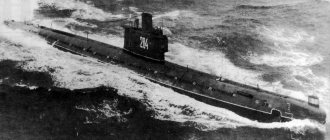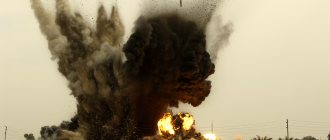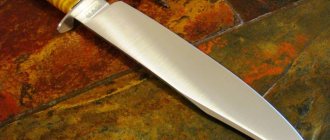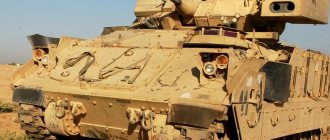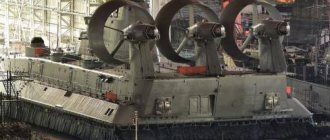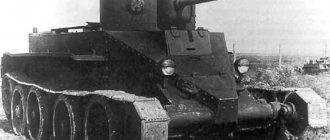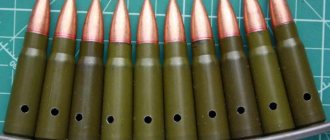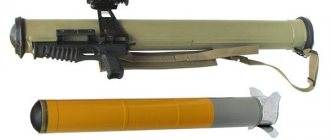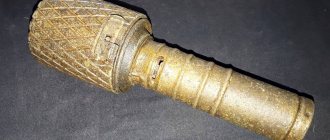Explosives (abbreviated as explosives) are special chemical compounds, as well as mixtures thereof, that are capable of exploding under the influence of external conditions or ongoing internal processes, resulting in the formation of extremely heated gases and the release of heat. There are three groups of explosives that have different susceptibility to external influences and different types of explosion. These include: initiating, propelling, and blasting substances. This article provides information about high explosives and their areas of application.
General concepts
An explosion is the rapid transformation of an explosive into a significant amount of extremely compressed and heated gases, which, expanding, do the following work: move, crush, destroy, eject.
An explosive is a mechanical mixture or combination of chemical elements that can quickly transform into gases. An explosion is similar to the burning of coal or wood, but differs in the high speed of this process, which is often ten-thousandths of a second. Depending on the speed of transformation, explosions are divided as follows:
- Combustion. The transfer of energy from one layer of a substance to another occurs due to thermal conductivity. The process of combustion and the formation of gases occurs at a low speed. Such an explosion is characteristic of gunpowder, in which the bullet is ejected, but the cartridge case is not destroyed.
- Detonation. Energy is transferred from layer to layer almost instantly. Gases are formed at supersonic speeds, pressure rapidly increases, and severe destruction occurs. Such an explosion is inherent in hexogen, ammonite, and TNT.
In order for the explosion process to begin, an external influence on the explosive is required, which is of the following types:
- detonation - explosion of another explosive nearby;
- thermal - heating, spark, flame;
- chemical – chemical reaction;
- mechanical - friction, puncture, impact.
Explosive substances react differently to external influences:
- some are capable of exploding quickly;
- others are sensitive only to certain effects;
- still others can explode even without any influence on them.
Basic properties of explosives
Their main properties are:
- susceptibility to external influences;
- brisance;
- characteristic state of aggregation;
- the amount of energy released during an explosion;
- chemical resistance;
- rapidity of detonation;
- density;
- explosiveness;
- duration and circumstances of the working condition.
Each explosive can be described in detail using all its characteristics, but in most cases two of them are used:
- Brisance (break, crush, shatter). That is, this is the ability of an explosive to produce destructive effects. The higher the brisance, the faster the gases are formed during the explosion and the explosion occurs with greater force. As a result, the shell of the projectile will shatter well, the fragments will scatter at high speed, and a strong shock wave will occur.
- High explosiveness is a measure of the performance of an explosive that performs destructive, throwing and other actions. The main influence on it is the volume of gas released during the explosion. A huge amount of gas can carry out great work, for example, throwing concrete, soil, bricks out of the explosion area.
High explosives with high explosiveness are suitable for blasting in mines, when eliminating ice jams, and constructing various pits. When making shells, attention is first paid to high explosiveness, and high explosiveness recedes into the background.
NYAMNBMSHHLH NDMNPNDMSHLH APHGYUMRMSHLH bb, MYUNDYHLH OPHLEMEMHE B YUBKHYUZHNMMSHU yao, ЪБКЪЧРЯ РПНРХК, РИРПХК, ЦeiЯНЦ, ННИРНЦМ Х РШЧМ.rPNRHK (RPHMHRPNRNASNK, rmr, RNA) - YPHYARYUKKKHVEYAYNE BEYYYARBN FEKRNTSN ZHBERYU, YNRNPNE UNPNN OPEYASERYA KH OKYUBHRYA OPH RELOEPYURSPE +81╟ya. rPNRHK OPYURKHVEYAYKH ME BGYUKHLNDEIYARBSER I LERYUKKYULKH, UHLKHVEYAYKH YARNEY (LNFER UPYUMHREYA DEYAYRIYKH KER). VSBYARBHREKEMNYARE Y SDYUPS YAPYUBMHREKEMN MEBEKKHYU (OPH OPNYARPEKE OSKEY ME BGPSHBUERYAJ), ONDNFFEMMSHI RPNRHK MU NRYPSHRNL BNGDSUE YATSNPYUER AEG BGPSHBYU. b VHYARNL BHDE RPNRHK HYAONKEGSERYAJ DK YAMYUPFEMHYUBHYUANLA H ANEBSHU VYUYAREI PUYER. YaMYUPFEMKHE ANEOKHOYYANB NASHVMN OPNKHGBNDHRYA OPEDBYUPHREKEMN PUYAOKYUBKEMMSHL RPNRHKNL OSREL ETSN GYUKHBYKH. rPNRHK ҪХПНН ОПХЛМЪРИАЪ B YUVEYARBE OKYUBYNI YNLONMEMRSH B YAOKYUBYU I ANKEE LNYMSHLH bb.
rERPHK - YPHYARYUKKKHVEYAYNE BEYYARBN AKEDMN-FEKRNTSN ZHBERYU, UPNN OPEYAYASERYAJ, OKYUBKHRYAN YAN BGPSHBNL, VSBYARBKHREKEMNYARE Y SDYPS KH BNYaOPKHHLVKHBNYARE Y DERNMYUZHH X TSNPYUGDN BSHYE, VEL WITH RPNRRHKYU. rERPHK OPHLEMERYA DK KHCTSNRNBKEMKH DNONKMHREKEMSHU DERNMYURNPNB KH B YANYARYUBYU YUOYACHKEY-DERNMURNPNB.
TSEYANTSEM, NYRNTSEM H RSHHM - YPHYARYUKKHVEYAYHE BEYYARBU AEKNTSN ZHBERYU, UNPNN OPEYASCHRYA, OKYUBRYAN YAN BGPSHBNL. nRKHVYUCHRYA NR RPNRKHKYU BSHYANYNI VSBYARBKHREKEMNYARECH Y SDYUPS H ANKEYEI LNIMNYARECH. Tseyantsem, NYRNTSEM X RSHHM NRMNYARYAJ VHYAKS MYUKHANKEE LNYMSHU bb, OPHLEMEMKHE YNRNPSHU B VHYARNL BHDE NTSPYUMKHVEMN HG-GYU BSHYANYNI VSBYARBKHREKEMNYARKH Y SDYPS X MEBNGLNF MNYARKH OPNHGBNDHRE YAMYUP'FEMKHE OPNYARSHLH YAONYANAYULH (GUKKHBYNI).
LEUUMHVEYAYU YALEYAE TKETSLURKHGHPNBUMMNTSN TSEYANTSEMYU I YUKCHLHMKHEBNI OSDPNI NAKYUDUER YAHKEMSHL TSSUYAMSHL H GUFKHTSYUREKEMSHL DEYARBHEL. ONBSHIEMMYU TSTSYUYAMNYARE DEIYARBKH YALEYAH NASYAKNBKEMYU YUKCHLHMHEL, YNRNPSHI ONYAKE DERNMYUZHHH BYARSOYUER B PEYUYZHHH I OPNDSYRYULH BGPSHBU (OYUPYULH BNDSH, STSKEYHYAKNRNI X NY HYAECH STSKEPNDYU), YATsNPYU GYU YAVER YANDEPFYUYETSNYA B MKHU YHYAKNPNDYU. schRH PEYUYZHH YANOPNBNFDYUCHRYA BSDEKEMHEL ANKENNTSN YNKKHVEYARBU REOKYU (OPH YATSNPYUMHH 1 YTS YUKCHLHMKH BSHDEKERYA B YAELE I KHMHHL PYUG ANKEYE SHCHMEPTSKHH, VELP OPH BGPSHBE 1 YC RPNRHKYU).
bSHDEKEMMNE HGASHRNVMNE REOKN OPENAPYUGSERYA B LEUUMHVEYAYSCH PYUANRS, YANBEPIUELSCH OPNDSYRYULH BGPSHBYU, R.E. oPKH YATsNPYUMKH YUKCHLKHMKH NAPYUGSCHRYA PYUAYYUKEMMSHE RBEPDSHE KBYUYKH NYHYAKNB YUKCHLKHMKH, YNRNPSHE NAEYAOEVKHBUCHR GUFKHTSYUREKEMNE DEYARBKHE BGPSHBYU.
YaOKYUBSH RPNRHKYU I TSEYANTSEMNL KHTsNRNBKCHRYA BBEDEMKHEL B PYYYAOKYUBKEMMSHI RPNRHK ONPNYINNAPUGMNTSN TSEYANTSEMYU (RELOEPYURSPYU OKYUBKEMHYA +203.5╟ya), YNRNPSHI MUUNDHRYA Kommersant B MEL B BHDE BGBEYAH. YAOKYUBSH ON LNYNYARH OPEBNYAUNDER RPNRKHK, GMYuVKHREKEMN LEMEE VSBYARBHREKEMSH, VEL VKHYARSHI TSEYANTSEM, KH NAKYUDUCHR BSHsNYNI BNYAOPHHLVKHBNYARECH Y DERNMYUZHHH.
dKЪ ONBSHYEMH TSTSYUYAMNTSN DEIYARBKH BGPSHBU B YAOKYUBSH DNAYUBKCHR ONPNNYNNAPYUGMSHYUKCHLHMKHI. MEDNYARYURYNL RYUKHU YAOKYUBNB ЪБКЪеряЪ ONБШЪММУЪ VSBYARBHREKEMNYARE Y SDYUPS KH RPEMKHCH. schRNR MEDNYARYURNY SYARPUMYERYA BBEDEMKHEL B YAOKYUB TKETSLYURKHGYURNPNB, YNRNPSHE YAMKHFYUCHR VSBYARBKHREKEMNYARE ETSN DN SPNBM VSBYARBKHREKEMNYARKH RPNRKHKYU, ME NYUGSHB YU OPH SCHRNL YASYYYARBEMMNTSN BKHJMKH MU LNYMNYARE YAOKYUBYU.
Classification
Explosives have several classifications. Based on their properties, they are divided as follows:
- Initiating - are used to undermine other explosives. They have a high sensitivity to initiation factors and have a higher detonation speed. They are also called primary explosives, which are capable of exploding from a weak mechanical impact. The group includes: diazodinitrophenol, mercury fulminate.
- High explosives are characterized by high brisance and are used as the main charge for most ammunition. These are secondary explosives that are less sensitive to external influences in relation to primary explosives. In their chemical composition they contain nitrates and their compounds and have a powerful explosive effect. For their explosion, a small amount of initiating substances is used.
- Throwing - serve as a source of energy for throwing bullets, shells, grenades. These include different types of rocket fuels and gunpowder.
- Pyrotechnic compositions – used for special ammunition. When burned, they give a characteristic effect - signaling, lighting.
In addition, according to their physical condition, they are:
- hard;
- liquid;
- gaseous;
- emulsion;
- suspensions;
- plastic;
- gel-like;
- elastic.
general characteristics
Opening the front door using a compact demolition charge (2008)
Any explosive has the following characteristics:
- ability for exothermic chemical transformations
- ability to undergo self-propagating chemical transformation
The most important characteristics of explosives are:
- speed of explosive transformation (detonation speed or burning speed),
- detonation pressure,
- heat (specific heat) of explosion,
- composition and volume of gas products of explosive transformation,
- maximum temperature of explosion products (explosion temperature),
- sensitivity to external influences,
- critical detonation diameter,
- critical detonation density.
During detonation, the decomposition of explosives occurs so quickly (in a time from 10−6 to 10−2 sec) that gaseous decomposition products with a temperature of several thousand degrees are compressed in a volume close to the initial volume of the charge. Expanding sharply, they are the main primary factor in the destructive effect of the explosion.
There are two main types of action of explosives: high explosive (local action) and high explosive (general action).
Stability is essential when storing and handling explosives.
In applied fields, no more than two to three dozen explosives and their mixtures are widely used. The main characteristics of the most common of them are summarized in the following table (data given at a charge density of 1600 kg/m3):
| Explosive | Oxygen balance,% | Heat of explosion, MJ/kg | Volume of explosion products, m3/kg | Detonation speed, km/s |
| TNT | -74,0 | 4,2 | 0,75 | 7,0 |
| Tetryl | -47,4 | 4,6 | 0,74 | 7,6 |
| RDX | -21,6 | 5,4 | 0,89 | 8,1 |
| Ten | -10,1 | 5,9 | 0,79 | 7,8 |
| Nitroglycerine | +3,5 | 6,3 | 0,69 | 7,7 |
| Ammonite No. 6 | 4,2 | 0,89 | 5,0 | |
| Ammonium nitrate | +20,0 | 1,6 | 0,98 | ≈1,5 |
| Lead azide | not applicable | 1,7 | 0,23 | 5,3 |
| Ballistic powder | -45 | 3,56 | 0,97 | 7,0 |
High explosives
Blasting substances got their name from the French word briser, which translated into Russian means to break, crush. Such explosives can be either individual chemical compounds - PETN, TNT, nitroglycerin, or mixtures - dynamite, dynamone, ammonite. They do not detonate from simple impulses: a beam of flame or a spark, which is sufficient to explode the initiating substances. The low susceptibility of high explosives to heat, friction and impact ensures safety when working with them. They are used for the manufacture of fragmentation and aviation bombs, naval and engineering mines, where a powerful explosion with crushing of the shell of the projectile is required.
Explosive dye
In 1868, the British chemist Frederick Augustus Abel, after six years of research, managed to obtain pressed pyroxylin. However, with regard to trinitrophenol (picric acid), Abel was assigned the role of “authoritative brake”. Since the beginning of the 19th century, the explosive properties of picric acid salts were known, but no one realized that picric acid itself was capable of explosion until 1873. Picric acid has been used as a dye for a century. At a time when vigorous testing of the explosive properties of various substances began, Abel authoritatively declared several times that trinitrophenol was absolutely inert.
Three-dimensional model of the trinitrophenol molecule.
Hermann Sprengel was German by birth, but lived and worked in Great Britain. It was he who gave the French the opportunity to make money from secret melinitis.
In 1873, the German Hermann Sprengel, who created a whole class of explosives, convincingly demonstrated the ability of trinitrophenol to detonate, but another difficulty arose - pressed crystalline trinitrophenol turned out to be very capricious and unpredictable - it either did not explode when necessary, or exploded when it was not necessary.
Picric acid was brought before the French Explosives Commission. It was found that it is a powerful blasting substance, second only to nitroglycerin, but it is slightly let down by the oxygen balance. It was also found that picric acid itself has low sensitivity, and its salts formed during long-term storage detonate. These studies marked the beginning of a complete revolution in views on picric acid. Distrust in the new explosive was finally dispelled by the work of the Parisian chemist Turpin, who showed that fused picric acid unrecognizably changes its properties compared to the pressed crystalline mass and completely loses its dangerous sensitivity.
This is interesting:
Later it turned out that fusion solved problems with detonation in an explosive similar to trinitrophenol - trinitrotoluene.
Such research, of course, was strictly classified. And in the eighties of the 19th century, when the French began to produce a new explosive called “melinite,” Russia, Germany, Great Britain and the United States showed great interest in it. After all, the high-explosive effect of ammunition filled with melinite looks impressive even today. Intelligence began to work actively, and after a short time the secret of melinite became an open secret.
In 1890, D.I. Mendeleev wrote to the Minister of the Navy Chikhachev: “As for melinite, the destructive effect of which exceeds all these tests, then according to private sources from different sides it is uniformly understood that melinite is nothing more than fused under great pressure cooled picric acid"
.
High power blasting agents
Explosives with increased power have a high detonation speed and release a significant amount of heat during an explosion. They are very sensitive to external impulses.
An explosion occurs from any detonator, including the impact of a rifle bullet. When exposed to open fire, they burn strongly, without emitting soot and smoke, with a light flame, and an explosion is possible. This group of substances includes:
- TENG is a white powder consisting of crystals. This blasting substance does not react with metals and water, is diluted in acetone and is considered the most vulnerable to external factors. It is used for detonation cords, auxiliary detonators and blasting caps.
- Tetryl is a yellowish crystalline powder with a salty taste. It dilutes well with acetone and gasoline, poorly with alcohol, does not react with metals, and lends itself well to pressing. Used to make detonators.
- Hexogen is one of the most explosive substances, which consists of small white crystals that are odorless and tasteless. It does not react with water and metals and is difficult to press. An explosion occurs from external influence, burns with a hiss, the flame is bright white. Used for some samples of detonator caps, the production of mixtures for industrial explosions, and sea mines.
High explosives with normal power
These substances have a long shelf life (with the exception of dynamite), they are not significantly affected by external factors, and are safe in practical use.
High explosives include:
- TNT is a substance in the form of crystals, yellowish or brownish in color, and tastes bitter. The melting point is 81 °C, and the flash point is 310 °C. In the open air, TNT combustion is accompanied by a yellowish flame with strong soot without an explosion, and in a closed room detonation can occur. The substance does not exhibit chemical activity with metals and is practically insensitive to shock, friction and thermal effects. It interacts with hydrochloric and sulfuric acid, gasoline, alcohol, and acetone. For example, when shot by a cast and pressed rifle bullet, TNT does not ignite and no explosion occurs. For ammunition it is used in various alloys and pure form. The substance is used in the form of pressed blocks of various sizes when performing blasting operations.
- Picric acid is a blasting substance in the form of crystals that have a yellow color and a bitter taste. It is more susceptible to heat, impact and friction than TNT, and can explode from a rifle bullet. The flame produces a lot of smoke when burning. When a large accumulation of substance occurs, detonation occurs. Compared to TNT, picric acid is a more powerful explosive.
- Dynamites have different formulations and contain nitroglycerin, nitroesters, saltpeter, wood flour and stabilizers. The main application is the national economy. The main properties of dynamites are water resistance and significant power. Their disadvantage is considered to be increased susceptibility to thermal and mechanical influences. This requires caution during transportation and blasting. After six months, dynamites lose their ability to detonate. In addition, they freeze at negative temperatures of about 20 ° C and become dangerous during operation.
1.5. Brief information about the main explosives
Depending on their sensitivity to external influences and their ability to transition from combustion to detonation, explosives are divided into three main groups of explosives.
Initiating or primary explosives are used to initiate detonation or combustion of explosives of other groups. Combustion and detonation of initiating explosives occurs with an insignificant expenditure of external energy as a result of thermal or mechanical effects (heating, impact, friction).
High explosives, or secondary explosives, are used to make explosive rounds for ammunition and for blasting purposes. Their combustion turns into detonation only under certain conditions (for example, when burning a large mass of a substance with a large number of pores or when burning in a closed, durable vessel). When using high explosives, detonation is caused by the explosion of an auxiliary charge of the initiating (primary) explosive or by the explosion of a charge of another high explosive.
Gunpowder, or propellant explosives, are used as propellant charges for firearms and as fuel for jet engines. In composition they are close to high explosives, but their combustion is more stable. The combustion of gunpowder does not turn into detonation even at a pressure of several thousand atmospheres.
Under certain conditions (for example, when they are exposed to a sufficiently powerful initial impulse or if their diameter is larger than the critical one), gunpowder can detonate. Some of the gunpowders have a large critical diameter, and, in addition, the detonation of gunpowders is possible only with the explosion of a powerful detonator - for these reasons, the opinion arose that gunpowders cannot detonate.
Initiating explosives
Mercury fulminate [Hg(CNO)2] is a salt of fulminate acid HCNO, mercury fulminate is a white or gray crystalline powder with a density of 4.4 g/cm3. Flash point 175 – 1800C. Easily explodes from minor impact and friction. The decomposition of fulminate mercury occurs in accordance with the equation
[Hg(CNO)2]Hg+ 2CO+N2+ 494 kJ.
It can burn, but combustion easily and quickly turns into detonation. There are known cases of detonation as a result of a falling box of dry mercury fulminate, as a result of an object falling onto scattered mercury fulminate, etc. Sensitivity to the mechanical and thermal effects of mercury fulminate decreases in the presence of water (with a content of 30% water, it does not even ignite, but can be exploded by a detonator capsule). Mercury fulminate reacts vigorously with aluminum in the presence of moisture, so it should not be stored in aluminum containers, and mercury fulminate blasting caps are not made of aluminum. Aluminum fulminates are very sensitive compounds. A similar reaction is the formation of copper fulminate, a compound sensitive to shocks. Copper capsules are protected from moisture by varnishing inside and out.
Salts of explosive acid - fulminates - are extremely dangerous, because explode when wet and even under water (especially fulminates of mercury, gold and silver). When a splash of water containing mercury fulminate dries, the solid residue explodes under the influence of sunlight. Dust, as well as all wash water and water waste from the production of fulminates, are prone to spontaneous explosion and before removal must be neutralized by heating to 90 - 950C, which is also unsafe. Fulminates are used in pyrotechnics as fuses for other explosives, for gilding (explosive gold), for the manufacture of caps and fuses. All these drugs explode from impact, falling, friction, shock, heat, flame, acids and sunlight. Mercury fulminate is used to equip primers - igniters and primers - detonators. Due to the high sensitivity of dry mercury fulminate to mechanical stress, it can only be transported in equipped products. Long-term storage of mercury fulminate in front of equipment is permitted only under water.
Lead azide [Pb(N3)2] is a salt of hydronitric acid HN3, white powder with a density of 4.8 g/cm3 and a flash point of 330-3400C. Has high sensitivity. There are known cases where lead azide exploded as a result of pressing a fingernail on its crystals. To reduce sensitivity, it is phlegmatized with paraffin. When moistened, lead azide does not lose its sensitivity. When ignited by an external heat source, it instantly detonates. Interacts with copper, does not interact with aluminum. Lead azide is used to fill detonator caps. Hydronitric acid HN3 in anhydrous form can explode even by simply shaking the vessel. In a dilute aqueous solution during storage, it practically does not decompose. Its vapors are very poisonous, solutions cause inflammation of the skin.
The explosive decomposition of hydronitric acid follows the equation: HN3H2+ 3N2+ 590 kJ
Lead trinitroresorcinate (TNRS) [C6H(NO2)3(O2Pb)H2O] is a yellow-brown powder with a density of 3.1 g/cm3 and a flash point of 2750C. The impact sensitivity is lower than lead azide and the ignition sensitivity is higher. Used for equipping igniter primers.
Tetrazene or guanylnitrosoaminoguanyltetrazene [C2H8ON10] NH2 NH–NH-NO NH=C–NH–N=N–C=NH
Fine-crystalline yellowish powder with a density of 1.65 g/cm3 and a flash point of about 1400C. Slightly hygroscopic. It is close in sensitivity to mercury fulminate. Does not interact with metals.
Reduced explosive power
Low-power high explosives have reduced performance due to low detonation speed and low heat generation. They are inferior in brisance properties to those substances that have normal power, but have the same high explosiveness. The most commonly used explosives from this group are made on the basis of ammonium nitrate. These include:
- Ammonium nitrate is a white or yellowish crystalline substance, which is a mineral fertilizer, perfectly soluble in water. It belongs to insensitive, weakly explosive substances. It does not ignite from fire or sparks; the combustion process begins only in a strong source of flame. The low cost of ammonium nitrate makes it possible to produce inexpensive explosives from it when explosives or flammable substances are added to it.
- Dynamons are a mixture of ammonium nitrate with flammable but non-explosive substances, such as charcoal, peat or sawdust.
- Ammonals are mixtures for explosions containing nitrate, with the addition of flammable and explosive additives and aluminum powder to increase the heat of explosion.
All types of high explosives made from ammonium nitrate are safe to use. They do not fly into the air when rubbed, hit, or shot by a rifle bullet. Lit in air, they burn quietly, without exploding, with a yellow flame with soot. For storage, they are stored in well-ventilated areas. Sometimes fatty acids and iron sulfide are added to saltpeter, which promotes long-term residence of explosives in water without loss of properties.
The most powerful non-nuclear explosives: hexogen, heating elements and the “Chinese destroyer”
The nuclear age has not taken away the palm from chemical explosives in terms of frequency of use, breadth of application - from the army to oil production, as well as ease of storage and transportation. They can be transported in plastic bags, hidden in ordinary computers, and even simply buried in the ground without any packaging with the guarantee that detonation will still occur. Unfortunately, most armies on Earth still use explosives against people, and terrorist organizations use them to strike against the state. However, the Ministry of Defense remains the source and customer of chemical developments.
RDX
Hexogen is a high explosive based on nitramine. Its normal state of aggregation is a fine-crystalline, white, tasteless and odorless substance. Insoluble in water, non-hygroscopic and non-aggressive. Hexogen does not react chemically with metals and is difficult to press. For RDX to explode, one strong blow or shot from a bullet is enough, in which case it begins to burn with a bright white flame with a characteristic hiss. Combustion turns into detonation. The second name for hexogen is RDX, Research Department eXplosive - the explosive of the research department.
High explosives are substances in which the rate of explosive decomposition is quite high and reaches several thousand meters per second (up to 9 thousand m/s), as a result of which they have crushing and splitting ability. Their predominant type of explosive transformation is detonation. They are widely used for loading shells, mines, torpedoes and various demolition devices.
Hexogen is produced by nitrolysis of hexamine with nitric acid. During the preparation of hexogen by the Bachmann method, hexamine reacts with nitric acid, ammonium nitrate, glacial acetic acid and acetic anhydride. The raw material consists of hexamine and 98-99 percent nitric acid. However, this complex exothermic reaction is not completely controlled, so the end result is not always predictable.
RDX production peaked in the 1960s, when it was the third largest explosive produced in the United States. The average production of RDX from 1969 to 1971 was about 7 tons per month.
Current U.S. production of RDX is limited to military use at the Holston Army Ammunition Plant in Kingsport, Tennessee. In 2006, the Army Ammunition Plant in Holston produced over 3 tons of RDX.
Hexogen molecule
RDX has both military and civilian applications. As a military explosive, RDX can be used alone as the main charge for detonators or mixed with another explosive such as TNT to form cyclotols, which provide the explosive charge for aerial bombs, mines and torpedoes. Hexogen is one and a half times more powerful than TNT, and can be easily activated with mercury fulminate. A common military use of RDX is as an ingredient in plastid-bonded explosives, which have been used to fill almost all types of ammunition.
In the past, byproducts of military explosives such as RDX were openly burned in many Army munitions plants. There is written evidence that up to 80% of waste ammunition and rocket fuel over the past 50 years have been disposed of this way. The main disadvantage of this method is that explosive pollutants often end up in the air, water and soil. RDX ammunition has also previously been disposed of by dumping it into deep sea waters.
HMX
HMX is also a high explosive, but it already belongs to the group of high-power explosives. According to American nomenclature it is designated as HMX. There is much speculation as to what the acronym stands for: High Melting eXplosive or High-Speed Military eXplosive. But there are no records confirming these guesses. It could just be a code word.
Originally, in 1941, HMX was simply a by-product of the production of RDX by the Bachmann method. The HMX content in such RDX reaches 10%. Minor amounts of HMX are also present in RDX obtained by the oxidative method.
In 1961, Canadian chemist Jean-Paul Picard patented a method for producing HMX directly from hexamethylenetetramine. The new method made it possible to obtain an explosive with a concentration of 85% with a purity of more than 90%. The disadvantage of the Picard method is that it is a multi-step process - it takes quite a long time.
In 1964, Indian chemists developed a one-step process, thereby significantly reducing the cost of HMX.
HMX, in turn, is more stable than RDX. It ignites at a higher temperature—335°C instead of 260°C—and has the chemical stability of TNT or picric acid, plus it has a higher detonation rate.
HMX is used where its high power exceeds the cost of purchasing it - about $100 per kilogram. For example, in missile warheads, a smaller charge of a more powerful explosive allows the missile to travel faster or have a longer range. It is also used in shaped charges to penetrate armor and penetrate barriers from defensive structures where a less powerful explosive may not be able to cope. HMX as blasting charges is most widely used when carrying out blasting operations in particularly deep oil wells, where there are high temperatures and pressures.
HMX is used as an explosive when drilling particularly deep oil wells.
In Russia, octogen is used to carry out perforation and blasting operations in deep wells. It is used in the manufacture of heat-resistant gunpowder and in heat-resistant electric detonators TED-200. HMX is also used to equip the DShT-200 detonating cord.
HMX is transported in waterproof bags (rubber, rubberized or plastic) in the form of a paste mixture or in briquettes containing at least 10% liquid, consisting of 40% (by weight) isopropyl alcohol and 60% water.
A mixture of octogen with TNT (30 to 70% or 25 to 75%) is called octol. Another mixture, called okfol, which is a homogeneous friable powder from pink to crimson, consists of 95% octogen, desensitized by 5% plasticizer, this causes the detonation speed to drop to 8,670 m/s.
Solid desensitized explosives are moistened with water or alcohols or diluted with other substances to suppress their explosive properties.
Liquid desensitized explosives are dissolved or suspended in water or other liquid substances to form a homogeneous liquid mixture to suppress their explosive properties.
Hydrazine and astrolite
Hydrazine and its derivatives are extremely toxic to various types of animal and plant organisms. Hydrazine can be obtained by reacting an ammonia solution with sodium hypochlorite. Sodium hypochlorite solution is better known as bleach. Dilute solutions of hydrazine sulfate have a detrimental effect on seeds, seaweed, single-celled and protozoan organisms. In mammals, hydrazine causes convulsions. Hydrazine and its derivatives can penetrate into the animal body in any way: by inhaling product vapors, through the skin and the digestive tract. The toxicity of hydrazine to humans has not been determined. What is especially dangerous is that the characteristic odor of a number of hydrazine derivatives is felt only in the first minutes of contact with them. Subsequently, due to the adaptation of the olfactory organs, this sensation disappears and a person, without noticing it, can remain for a long time in a contaminated atmosphere containing toxic concentrations of the said substance.
Invented in the 1960s by chemist Gerald Hurst, astrolite is a family of binary explosives in a liquid state that are formed by mixing ammonium nitrate and anhydrous hydrazine (rocket fuel). The transparent liquid explosive, called Astrolite G, has a very high detonation speed of 8,600 m/s, almost twice that of TNT. In addition, it remains explosive in almost any weather conditions, as it is well absorbed into the ground. Field tests showed that Astrolit G detonated even after being in the ground for four days in heavy rain.
Tetranitropentaerythritol
Pentaerythritol tetranitrate (PETN) is a nitrate ester of pentaerythritol used as an energy and bulking material for military and civilian applications. The substance is produced as a white powder and is often a component of plastic explosives. It is widely used by rebel forces and was probably chosen by them because it is very easy to activate.
Appearance of the heating element
PETN retains its properties during storage longer than nitroglycerin and nitrocellulose. At the same time, it easily explodes under a mechanical impact of a certain force. It was first synthesized as a commercial explosive after World War I. It was appreciated by both military and civilian experts, primarily for its destructive power and effectiveness. It is placed in detonators, explosive caps and fuses to propagate a series of detonations from one explosive charge to another. A mixture of approximately equal parts of PETN and trinitrotoluene (TNT) creates a powerful military explosive called pentolite, which is used in grenades, artillery shells and shaped charge warheads. The first pentolite charges were fired from old bazooka-type anti-tank weapons during World War II.
Pentolite explosion in Bogota
On January 17, 2022, in the capital of Colombia, Bogotá, an SUV filled with 80 kg of pentolite crashed into one of the buildings of the General Santander police cadet school and exploded. The explosion killed 21 people; according to official figures, there were 87 injured. The incident was classified as a terrorist attack, since the car was driven by a former bomber of the Colombian rebel army, 56-year-old Jose Aldemar Rojas. Colombian authorities blamed the explosion in Bogota on a left-wing organization with which they have been unsuccessfully negotiating for the last ten years.
Pentolite explosion in Bogota
PETN is often used in terrorist attacks due to its explosive power, ability to be placed in unusual packaging, and difficulty of detection with X-ray and other conventional equipment. An electrically activated impact detonator can be detected during routine airport security if carried on the bodies of suicide bombers, but it can be effectively hidden in an electronic device in the form of a package bomb, as happened in the attempted bombing of a cargo plane in 2010. Then computer printers with cartridges filled with heating elements were intercepted by security agencies only because the intelligence services, thanks to informants, already knew about the bombs.
Plastic explosives are mixtures that are easily deformed even with minor forces and retain their given shape for an unlimited time under operating temperatures.
They are actively used in blasting for the manufacture of charges of any given shape directly at the blasting site. Plasticizers include rubbers, mineral and vegetable oils, and resins. The explosive components are hexogen, octogen, and pentaerythritol tetranitrate. Plasticization of an explosive can be carried out by introducing into its composition mixtures of cellulose nitrates and substances that plasticize cellulose nitrates.
Tricyclic urea
In the 80s of the last century, the substance tricyclic urea was synthesized. It is believed that the first to receive this explosive were the Chinese. Tests showed the enormous destructive power of urea - one kilogram of it replaced 22 kg of TNT.
Experts agree with these conclusions, since the “Chinese destroyer” has the highest density of all known explosives and at the same time has the maximum oxygen coefficient. That is, during the explosion, absolutely all the material is burned. By the way, for TNT it is 0.74.
In reality, tricyclic urea is not suitable for military applications, primarily due to poor hydrolytic stability. The very next day, with standard storage, it turns into mucus. However, the Chinese managed to obtain another “urea” - dinitrourea, which, although worse in explosiveness than the “destroyer”, is also one of the most powerful explosives. Today the Americans are producing it at their three pilot plants.
The ideal explosive is a balance between maximum explosive power and maximum stability during storage and transportation. Moreover, there is maximum chemical energy density, low cost of production and, preferably, environmental safety. Achieving all this is not easy, so for developments in this area they usually take already proven formulas and try to improve one of the desired characteristics without compromising the others. Completely new compounds appear extremely rarely.
Use of high explosives
High explosives are secondary explosives for which detonation is the main type of explosive transformation, excited due to the small charge of the initial explosive. They are endowed with the ability to crush and split. They are used to stuff mines, various explosive devices, torpedoes and shells. Substances with explosive properties represent a concentrated and economical source of mechanical energy. They are widely used in the national economy. Most non-ferrous ores, as well as almost all ferrous metals, are mined using explosions.
High explosives have found their application in the following areas:
- for the development of coal seams and mineral resource deposits;
- embankments for railways and roads;
- dam construction;
- digging water channels;
- laying gas and oil pipelines;
- development of mine shafts.
Where else are blasting substances used? In addition to the above, they are used:
- during soil compaction;
- carrying out irrigation systems;
- extinguishing forest fires;
- leveling and cleaning the area.
Research and development is also underway to expand the use of this powerful explosion energy - accelerating chemical processes using high pressures, artificial sprinkling and explosive drilling.
Chemistry and technology of high explosives
Molecules of chemical compounds or their mixtures containing a certain supply of chemical energy are called energy-saturated substances. Energy, as a result of transformation occurring under the influence of external factors, turns into light, mechanical or thermal.
Pyrotechnic compositions, gunpowder and other explosives are among the most well-known types of energy-saturated substances. Chemical energy in them is converted due to the rapid occurrence of the explosion into other types. The significant amount of heat released due to the explosion is the main criterion for its performance. Being compact and powerful sources of mechanical energy, high explosives are widely used in various industries.
